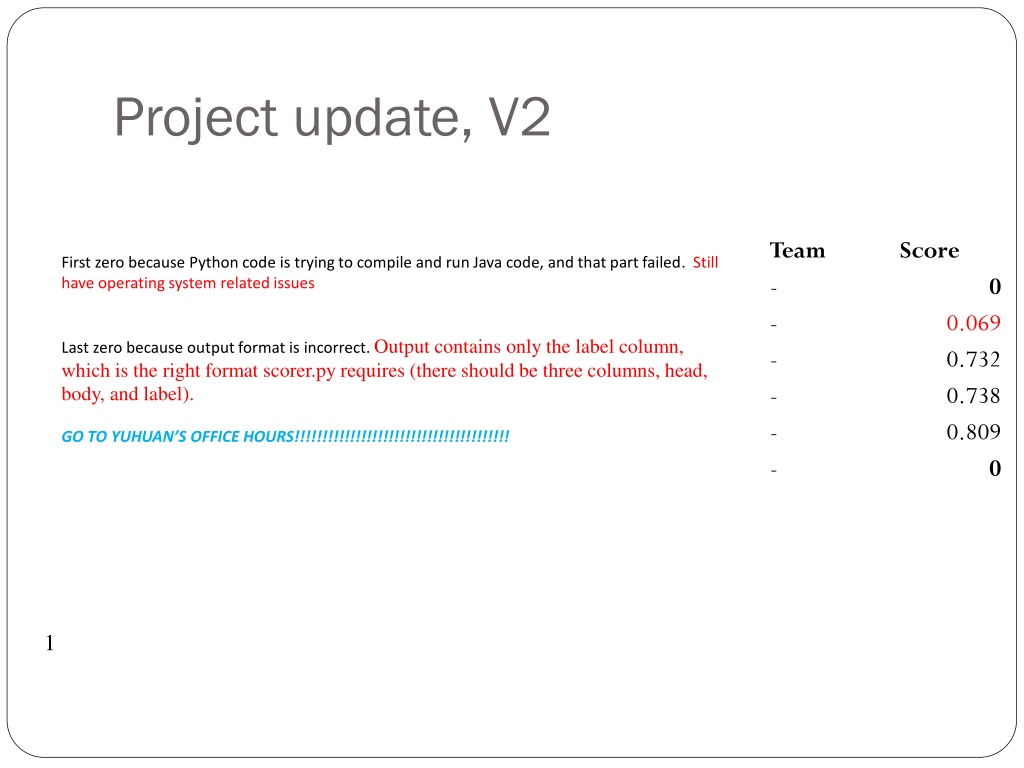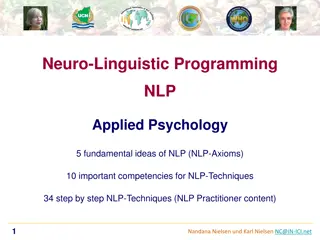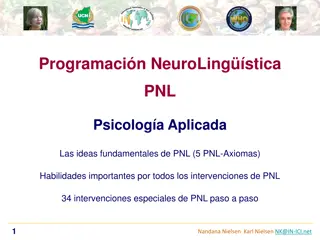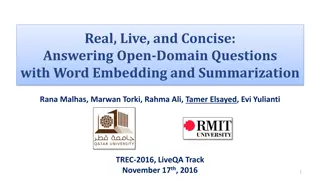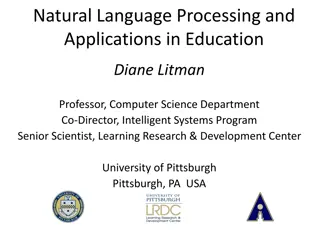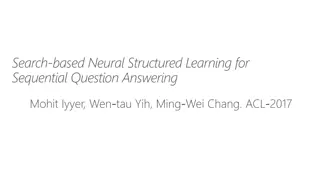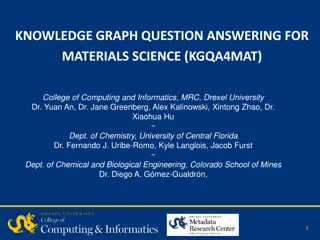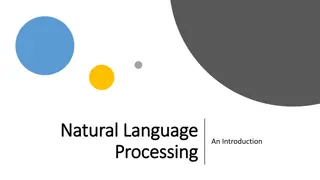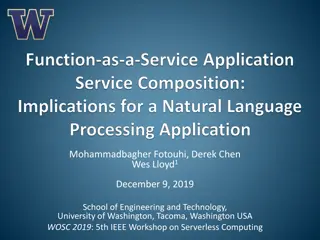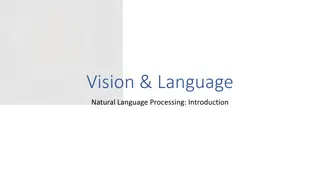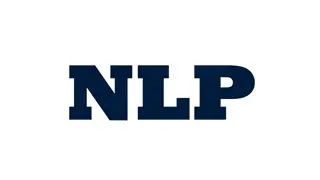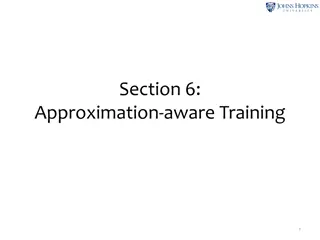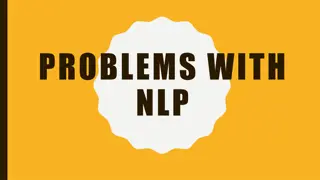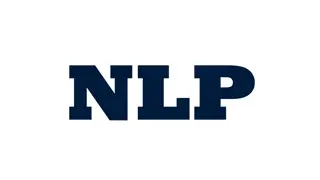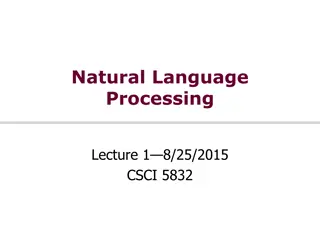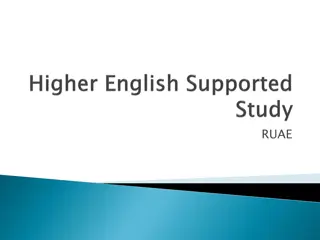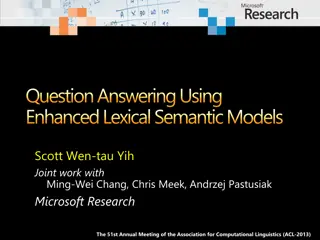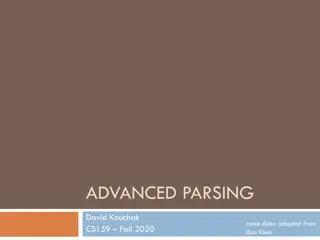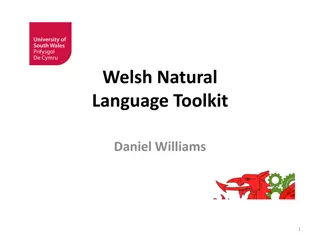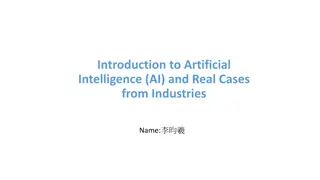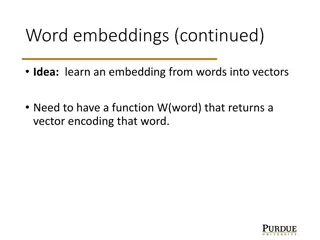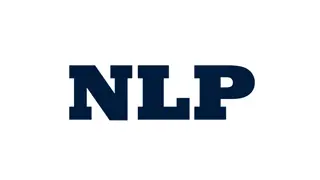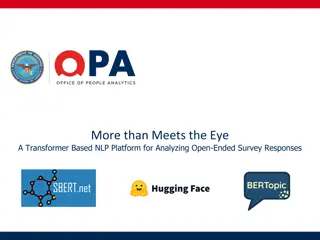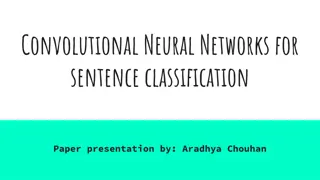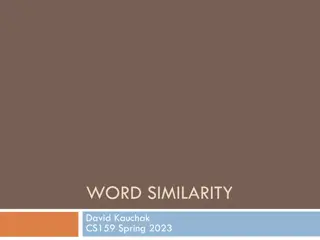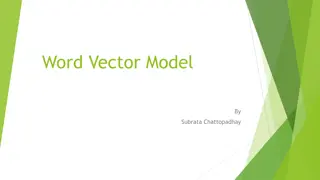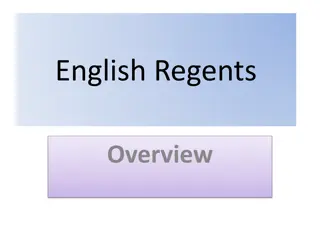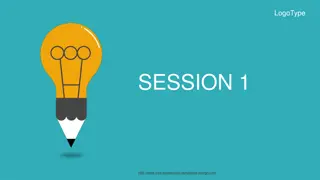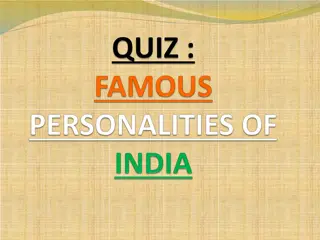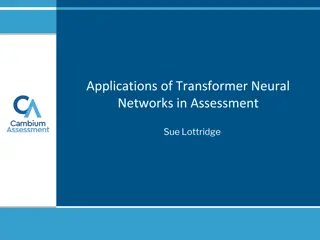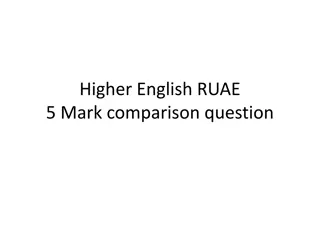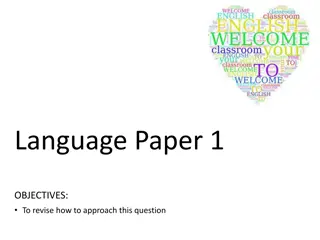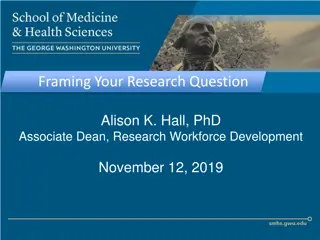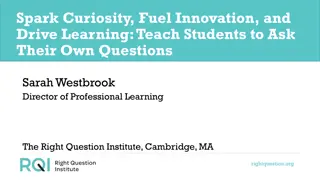Question Answering Systems in NLP: Overview and Applications
Question answering systems in natural language processing (NLP) have evolved significantly, offering solutions beyond just retrieving relevant documents. These systems cater to the fundamental human need for answers to specific questions. They excel in finding answers within document collections, databases, and mixed initiative dialog systems. Highlighted with examples like IBM's Watson and Apple's Siri, the importance of question answering in understanding and interaction is evident. Explore the realm of multiple document question answering tasks and the challenges they address. Delve into the TREC Q/A Task and its significance in the information retrieval domain.
Download Presentation

Please find below an Image/Link to download the presentation.
The content on the website is provided AS IS for your information and personal use only. It may not be sold, licensed, or shared on other websites without obtaining consent from the author. Download presentation by click this link. If you encounter any issues during the download, it is possible that the publisher has removed the file from their server.
E N D
Presentation Transcript
Project update, V2 Team - - - - - - Score First zero because Python code is trying to compile and run Java code, and that part failed. Still have operating system related issues 0 0.069 0.732 0.738 0.809 Last zero because output format is incorrect.Output contains only the label column, which is the right format scorer.py requires (there should be three columns, head, body, and label). GO TO YUHUAN S OFFICE HOURS!!!!!!!!!!!!!!!!!!!!!!!!!!!!!!!!!!!!!!! 0 1
Question-Answering Systems Beyond retrieving relevant documents -- Do people want answers to particular questions? One of the oldest problem in NLP Different kinds of systems Finding answers in document collections (www, encylopeida, books, manuals, medical literature, scientific papers, etc.) Interfaces to relational databases Mixed initiative dialog systems A scientific reason to do Q/A: the ability to answer questions about a story is the hallmark of understanding.
Question Answering: IBMs Watson Won Jeopardy on February 16, 2011! WILLIAM WILKINSON S AN ACCOUNT OF THE PRINCIPALITIES OF WALLACHIA AND MOLDOVIA INSPIRED THIS AUTHOR S MOST FAMOUS NOVEL Bram Stoker 4
Multiple Document Question Answering Multiple Document Question Answering A multiple document Q/A task involves questions posed against a collection of documents. The answer may appear in the collection multiple times, or may not appear at all! For this task, it doesn t matter where the answer is found. Applications include WWW search engines, and searching text repositories such as news archives, medical literature, or scientific articles.
TREC TREC- -9 Q/A Task 9 Q/A Task Number of Documents: Megabytes of Text: Document Sources: Number of Questions: Question Sources: 979,000 3033 AP, WSJ, Financial Times, San Jose Mercury News, LA Times, RBIS 682 Encarta log, Excite log Sample questions: How much folic acid should an expectant mother get daily? Who invented the paper clip? What university was Woodrow Wilson president of? Where is Rider College located? Name a film in which Jude law acted. Where do lobsters like to live?
TREC (Text TREC (Text REtrieval REtrieval Conference) and ACQUAINT Conference) and ACQUAINT TREC-10: new questions from MSNSearch logs and AskJeeves, some of which have no answers, or require fusion across documents List questions: Name 32 countires Pope John Paul II has visited. Dialogue processing: Which museum in Florence was damaged by a major bomb explision in 1993? On what day did this happen? ACQUAINT : Advanced Question and Answering for INTelligence (e.g., beyond factoids, the Multiple Perspective Q-A work at Pitt) Current tracks at http://trec.nist.gov/tracks.html
Single Document Question Answering Single Document Question Answering A single document Q/A task involves questions associated with one particular document. In most cases, the assumption is that the answer appears somewhere in the document and probably once. Applications involve searching an individual resource, such as a book, encyclopedia, or manual. Reading comprehension tests are also a form of single document question answering.
Reading Comprehension Tests Reading Comprehension Tests Mars Polar Lander- Where Are You? (January 18, 2000) After more than a month of searching for a single sign from NASA s Mars Polar Lander, mission controllers have lost hope of finding it. The Mars Polar Lander was on a mission to Mars to study its atmosphere and search for water, something that could help scientists determine whether life even existed on Mars. Polar Lander was to have touched down on December 3 for a 90-day mission. It was to land near Mars south pole. The lander was last heard from minutes before beginning its descent. The last effort to communicate with the three-legged lander ended with frustration at 8 a.m. Monday. We didn t see anything, said Richard Cook, the spacecraft s project manager at NASA s Jest Propulsion laboratory. The failed mission to the Red Planet cost the American government more the $200 million dollars. Now, space agency scientists and engineers will try to find out what could have gone wrong. They do not want to make the same mistakes in the next mission. When did the mission controllers lost Hope of communication with the Lander? (Answer: 8AM, Monday Jan. 17) Who is the Polar Lander s project manager? (Answer: Richard Cook) Where on Mars was the spacecraft supposed to touch down? (Answer:near Mars south pole) What was the mission of the Mars Polar Lander? (Answer: to study Mars atmosphere and search for water)
Question Types Simple (factoid) questions (most commercial systems) Who wrote the Declaration of Independence? What is the average age of the onset of autism? Where is Apple Computer based? Complex (narrative) questions What do scholars think about Jefferson s position on dealing with pirates? What is a Hajj? In children with an acute febrile illness, what is the efficacy of single medication therapy with acetaminophen or ibuprofen in reducing fever? Complex (opinion) questions Was the Gore/Bush election fair? 13
Commercial systems: mainly factoid questions Where is the Louvre Museum located? What s the abbreviation for limited partnership? What are the names of Odin s ravens? What currency is used in China? What kind of nuts are used in marzipan? What instrument does Max Roach play? What is the telephone number for Stanford University? In Paris, France L.P. Huginn and Muninn The yuan almonds drums 650-723-2300
IR-based Question Answering (e.g., TREC, Google) a 15
Many questions can already be answered by web search 16
IR-Based (Corpus-based) Approaches (As opposed to knowledge-based ones) We assume an Information Retrieval (IR) system with an index into documents that plausibly contain the answer(s) to likely questions. And that the IR system can find plausibly relevant documents in that collection given the words in a user s question. 1. 2. 17
Knowledge-based Approaches (e.g., Siri) Build a semantic representation of the query Times, dates, locations, entities, numeric quantities Map from this semantics to query structured data or resources Geospatial databases Ontologies (Wikipedia infoboxes, dbPedia, WordNet) Restaurant review sources and reservation services Scientific databases 18
Hybrid approaches (IBM Watson) Build a shallow semantic representation of the query Generate answer candidates using IR methods Augmented with ontologies and semi-structured data Score each candidate using richer knowledge sources Geospatial databases Temporal reasoning Taxonomical classification 19
Corpus-Based Approaches Factoid questions From a smallish collection of relevant documents Extract the answer (or a snippet that contains the answer) Complex questions From a smallish collection of relevant documents Summarize those documents to address the question Query-focused summarization 20
Full-Blown System QUESTION PROCESSING Parse and analyze question / Determine type of the answer i.e., detect question type, answer type, focus, relations Formulate queries suitable for use with IR/search engine PASSAGE RETRIEVAL Retrieve ranked results Break into suitable passages and rerank ANSWER PROCESSING Perform NLP on those to extract candidate answers Rank candidates based on NLP processing Using evidence from text and external sources
Question Processing Two tasks Answer Type Detection what kind of entity (person, place) is the answer? Query Formulation what is the query to the IR system We extract both of these from the question keywords for query to the IR system an answer type 24
Things to extract from the question Answer Type Detection Decide the named entity type (person, place) of the answer Query Formulation Choose query keywords for the IR system Question Type classification Is this a definition question, a math question, a list question? Focus Detection Find the question words that are replaced by the answer Relation Extraction Find relations between entities in the question 25
Question Processing They re the two states you could be reentering if you re crossing Florida s northern border Answer Type: Query: Focus: Relations: 26
Question Processing They re the two states you could be reentering if you re crossing Florida s northern border Answer Type: US state Query: two states, border, Florida, north Focus: the two states Relations: borders(Florida, ?x, north) 27
Factoid Q/A 28
Answer Type Detection: Named Entities Who founded Virgin Airlines? PERSON. What Canadian city has the largest population? CITY. 29
Answer Types Can Be Complicated Who questions can have organizations or countries as answers Who sells the most hybrid cars? Who exports the most wheat?
Answer Types Factoid questions Who, where, when, how many Who questions are going to be answered by Where questions Simplest: use Named Entities
Sample Text Sample Text Consider this sentence: President George Bush announced a new bill that would send $1.2 million dollars to Miami Florida for a new hurricane tracking system. After applying a Named Entity Tagger, the text might look like this: <Person= President George Bush > announced a new bill that would send <MONEY=$1.2 million dollars > to <LOCATION= Miami Florida: > for a new hurricane tracking system.
Rules for Name Entity Tagging Rules for Name Entity Tagging Many Named Entity Taggers use simple rules that are developed by hand. Most rules use the following types of clues: Keywords: Ex. Mr. , Corp. , city Common Lists: Ex. Cities, countries, months of the year, common first names, common last names Special Symbols: Ex. Dollar signs, percent signs Structured Phrases: Ex. Dates often appear as MONTH, DAY #, YEAR Syntactic Patterns: (more rarely) Ex. LOCATIONS_NP, LOCATION_NP is usually a single location (e.g. Boston, Massachusetts).
Named Entities If we are looking for questions whose Answer Type is CITY We have to have a CITY named-entity detector So if we have a rich set of answer types We also have to build answer-detectors for each of those types!
Answer Type Taxonomy (from Li & Roth, 2002) Two-layered taxonomy 6 coarse classes ABBEVIATION, ENTITY, DESCRIPTION, HUMAN, LOCATION, NUMERIC_VALUE 50 fine classes HUMAN: group, individual, title, description ENTITY: animal, body, color, currency LOCATION: city, country, mountain 35
Answer Type Taxonomy (2/2) distance size speed money weight date other NUMERI C abbreviation country LOCATION expression ABBREVIATION city definition DESCRIPTION group HUMAN manner individual ENTITY reason description animal vehicle body color 36
Answer Types 10/2/2024 37
More Answer Types 10/2/2024 38
Another Taxonomy of Answer Types Contains ~9000 concepts reflecting expected answer types Merges NEs with the WordNet hierarchy
Answer types in Jeopardy Ferrucci et al. 2010. Building Watson: An Overview of the DeepQA Project. AI Magazine. Fall 2010. 59-79. 2500 answer types in 20,000 Jeopardy question sample The most frequent 200 answer types cover < 50% of data The 40 most frequent Jeopardy answer types he, country, city, man, film, state, she, author, group, here, company, president, capital, star, novel, character, woman, river, island, king, song, part, series, sport, singer, actor, play, team, show, actress, animal, presidential, composer, musical, nation, book, title, leader, game 40
Answer Type Detection Hand-written rules Machine Learning Hybrids
Answer Type Detection Regular expression-based rules can get some cases: Who {is|was|are|were} PERSON PERSON (YEAR YEAR) Make use of answer-type word
Answer Type Detection Other rules use the question headword: = headword of first noun phrase after wh-word: Which city in China has the largest number of foreign financial companies? What is the state flower of California?
Answer Type Detection Most often, we treat the problem as machine learning classification Define a taxonomy of question types Annotate training data for each question type Train classifiers for each question class using a rich set of features. these features can include those hand-written rules! 44
Features for Answer Type Detection Question words and phrases Part-of-speech tags Parse features (headwords) Named Entities Semantically related words 45
Query Terms Extraction Grab terms from the query that will help us find answer passages Question (from TREC QA track) keywords Q002: What was the monetary value of the Nobel Peace Prize in 1989? Q003: What does the Peugeot company manufacture? monetary, value, Nobel, Peace, Prize, 1989 Peugeot, company, manufacture Q004: How much did Mercury spend on advertising in 1993? Mercury, spend, advertising, 1993 Q005: What is the name of the managing director of Apricot Computer? name, managing, director, Apricot, Computer
Keyword Selection Algorithm Dan Moldovan, Sanda Harabagiu, Marius Paca, Rada Mihalcea, Richard Goodrum, Roxana Girju and Vasile Rus. 1999. Proceedings of TREC-8. 1. Select all non-stop words in quotations 2. Select all NNP words in recognized named entities 3. Select all complex nominals with their adjectival modifiers 4. Select all other complex nominals 5. Select all nouns with their adjectival modifiers 6. Select all other nouns 7. Select all verbs 8. Select all adverbs 9. Select the QFW word (skipped in all previous steps) 10. Select all other words
Choosing keywords from the query Slide from Mihai Surdeanu Who coined the term cyberspace in his novel Neuromancer ? 1 1 4 4 7 cyberspace/1 Neuromancer/1 term/4 novel/4 coined/7 49
Factoid Q/A 50
